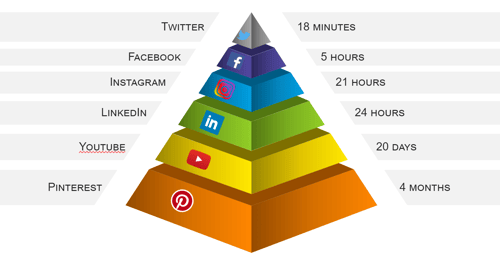8 min read
Social Media Marketing For Your Building Product And Construction Companies
![]() Olivia Atkinson
:
17-Dec-2019 14:42:33
Olivia Atkinson
:
17-Dec-2019 14:42:33

Social media can be a huge part of companies marketing efforts, contributing to brand awareness, increased traffic and lead generation. There is no one way that will work for every single company as they differ so much, especially in the building products sector.
However, there are best practises and techniques that have proven successful for companies in the past that we are sharing with you. To get an even deeper insight - download our definitive guide to social media.
Kick-start your marketing efforts, if you're feeling sceptical then trial a few suggestions, you've got nothing to lose.
Download The Definitive Guide To Social Media For Building Products
Why Social Media Is Essential For The Construction Industry
Certain industries can have different perceptions on social media and if they feel the need for their business to be present on it. There are 3 reasons why social media should be part of a building products marketing strategy:
- It’s an extremely visual market
- It's an important decision to make
- There’s a lot of competition
Products within the building products sector can be incredibly visual, some even a work of art.
Design is a huge part of many building products and services, and images are one of the best ways to portray this. Images and videos perform higher on all social media platforms over just text alone.
Typically products within the building products industry are an important part if not the main feature of a build. With this can come high costs meaning the decision becomes harder to make. Social media allows you to be present and on your audiences mind without bombarding them.
When contemplating and assessing which company is best to go with a prospect may look at 2 or 3 companies.
Part of this process may include checking out each companies social media. If 2 out the 3 companies haven’t posted for the last 6 months people may think your not in business anymore or inactive.
However if you’ve been posting informative content consistently you’re already 1 up on them as you’re active and have something to offer.
Social Media Strategies
There’s a lot of different social media platforms available, however that doesn’t mean you have to be present on all of them. Each social media platform has a different type of audience, for example Facebook is incredibly popular for B2C and LinkedIn is the place to be for B2B.
When first starting it’s wise to stick to one or two platforms whilst you understand where your audience are present. It’s a learning experience so part of your social media strategy should include constant trialling of different tactics to test and improve.
Part of being present on social media is being involved in the conversations and discussions taking place.
You should research and follow relevant accounts so you can comment and engage with them. Not only does it make you more visible but it also allows you to see what people are talking about within your specific space.
Try and be as helpful as possible on social media rather than selling. People go on the likes of Twitter to find out something new, read up on current affairs and more, not to be sold to. You should position yourself on social as the solution to a problem your customers or prospects have.
Content For Social Media
When it comes to creating content for social media there are so many options, standard text posts, images, videos, info-graphics, links, downloadable content and more.
Although it’s resourceful to use content your company already has, you should think about what content your prospects and customers would find useful and informative.
Specifically to the building products industry the content followers like to see include: case studies, current jobs (behind the scenes), blogs answering common questions, informative guides and e-books, specification information, reviews and demonstration videos of products.
Posting on social media should be about informing and educating the follower of how your product can be a solution to their problem.
When you have a set of posts created, roughly about 30 gives you enough to schedule for 1-4 weeks depending on the platforms you’re using, don’t be afraid to reuse them.
If you have an informative guide about how to specify for a specific industry, don’t just post it once a week in the hope someone will be on social at that exact moment to see it and click on it.
Dependent on the platform the lifetime of a post can differ hugely, meaning your chances of it being seen by your audience is slim.
Lifetime Of A Social Media Post

Tips For Posting On Social
There are few quick wins/changes you can make to your current social media efforts that will make for good habits going forward.
Post regularly - As just discovered, each platform has a different lifetime for their posts. So you will have to post on Twitter for example a lot more than you will LinkedIn.
You should be consistent with your posting, if you’re going to post on Twitter twice a day then make sure you do it for the foreseeable future not just for a week. Scheduling can help you manage and structure this.
Include a CTA/Link Back To Your Website - Sometimes you can get too bogged down with the actual content or imagery you’re posting that you forget to insert a link.
You should never be posting on social unless you have a reason and a message you’re tying to communicate. When people read your post they need somewhere to follow on to. Ensure you guide them with the appropriate link.
Double Check Spelling & Grammar- This sounds obvious, but you’d be surprised how many minor errors people make on social media. This is another reason to schedule your post as you can take your time checking for any grammatical errors. Grammarly is a great free tool for this.
Common Mistakes Made On Social Media
With so many users and people spending so much time on social media comes the do’s and don’ts. One thing that is an extremely successful marketing tactic is using humour. This may not apply to your product but keep it in mind for any campaigns you do to get your message across.
One mistake many companies make on social is they constantly promote themselves or product. Although your end goal is to sell you cannot make it your way of communicating. People want to make their own decision on a product, they turn off and lose interest when they detect sales talk.
Not using the data that gets given to you is another easy one you quickly improve. Each platform has an analytic section that shows you your best performing posts, most engaged follower and more.
Use this, do more of what works well and trial with different days and times to post. This way you get to understand your audience and when they engage with you.
Thinking social media is only for marketing is another common mistake companies make. Social media can be used for recruitment, customer service and sales conversations.
64% of people expect to get a response from a company on Twitter within an hour. The reality is that companies take a day, 7 hours and 12 minutes to respond. This shows the difference in expectations between social media platforms.
Find out what other common mistakes get made on social media everyday here.
Promoting Your Building Products Business On Social
There are several you can promote your content on social media. The first will be an easy win if you already pay for print PR.
When booking magazine space, always ask for the same PR to be published on their website and to share it on their social media platform. Some may charge for this but try and negotiate it as part of the PR package you’re already paying for.

Product directories work similarly, if you’re a member of one then make sure to send them content as often as you can. They crave content from their members so should push it onto social too.
Paid advertising is always an option on social media. It shouldn’t be used long term as it’s not sustainable, however it can be effective for campaigns or product launches. Facebook tends to be the cheapest platform to run a paid ad on. Knowing your audience is key to a successful paid campaign.
Find out more ways to promote your content on social.
Just How Effective Are Visuals?
Understanding just how impactful visuals can be and how they increase conversion rates is key to ensuring you’re engaging with your target audience on social media.
Visual Content Gets Better Recall
Studies have shown that people can recall 65% of the visual content that they see almost three days later as opposed to 10% of written content three days after its read.
People Share Info-graphics More
Research undergone by HubSpot has revealed that info-graphics are shared 3 times more than any other visual content on social media.
The Majority Of Marketers Use Visuals
As 75% of marketers use visuals on social media, it makes it harder to ensure that your visuals will stand out amongst the rest. One tip is to try and use original images and photography as much as possible. Although stock images can look good, people may have seen them before.
More Videos Are Watched Without Sound
As more and more people watch video, it's been revealed that 85% videos watched on Facebook are watched without sound. This is worth knowing when creating video, if there’s speech in your video ensure you put subtitles on.
Hashtags For Construction Marketing
Hashtags can be used across all social media platforms. A hashtag is a word or phrase preceded by the hash sign (#). It’s used especially on Twitter to identify messages on a specific topic.
Using hashtags on your posts is a great way of extending your reach and connecting with a wider audience on social media.
It can be a challenge to understand what words are the most effective as a hashtag. Ritetag is a free tool that you can use to research hashtags, revealing who used them recently.
This in itself gives you insight into what conversations are happening around a specific word, ensuring your stay relevant. HubSpot states that hashtags can increase your reach by 20%.
Not only does it allow you to get involved with conversations but it also gives you an insight into what other companies are doing and what content they’re promoting on social.
On twitter you’re capped by the character count, Instagram is a lot more lenient on this. However they restrict you to a maximum of 30 hashtags per post. This is because hashtags work on Instagram.
Although it’s best to do your research unique to your own company’s product or service, here are 50 of the best hashtags for construction marketing.
Understanding What Drives Sharing Of Online Content
After running through all the tips, tricks, do’s and don’ts of social media we’re taking a look into the psychology behind why people share content.
Why is this important? Well if you can understand why people share what they share you can then provide the content that encourages sharing, leading in increased engagement.
People are more likely to share content on new products or services. This is because people like to share content that they think will be useful to others. New products are also more attractive and shiny, creating a buzz.

People also share more content that arouses positive over negative emotion. Positive emotions are key to creating motivations for sharing. Content, images or adverts that create positive emotions such as excitement, joy and inspiration make viewers feel good.
People then feel positive towards the sharer as they’ve made them feel happy, enhancing the sharers' opportunity for self-enhancement.
View a more detailed blog for more information on the reason behind why we share content.
Converting Followers Into Buyers
Having a good social media following and high engagement is a great position to be in but ultimately you want to convert visitors into leads.
There are 3 things that you can implement to interlink your social media efforts with lead generation. They are:
- Integrate Social Media With Your CRM
- Have Clear CTA’s On Follow On Pages
- Create Dedicated Landing Pages
HubSpot is an example of a CRM system that integrates with your social media. You can not only schedule and publish posts through them but you can track how individual people have been created.
When you include a call to action (CTA) on your social post when they get to that page is there a call to action on there? Have you directed them to a product page that has little or no follow on?
When people visit your website your aim is to keep them on there as long as possible. As the longer they are on your website, the more they are educating themselves about your product. People can get distracted on websites so need clear CTA’s telling them what to do next.
To streamline your efforts even further you could create dedicated landing pages to the content you’re posting about. This way you control what your visitors see and guide them to take action like filling in a form or requesting a quote.
Conclusion
Overall it's clear that social media can be a big part of your marketing efforts if done well.
Social media isn't going anyway anytime soon so if you're going to spend time on it, make sure it's worth it. By implementing the best practises and your own data you should see an increase in engagement and website traffic.
Remember that the key to succeeding on social media is offering the correct content that your target market wants to see or share with their network. They'll only do this with content that they find helpful and informative.
For a deeper dive into social media for the building products and construction industry download the Definitive Guide To Social Media below.
About Insynth
As the only HubSpot certified agency to major on construction marketing, we bring together construction marketing strategy, digital strategy, website design, SEO, content marketing, email marketing, sales automation, marketing automation and HubSpot CRM implementation to produce successful campaigns and great results for our clients.

.jpg?width=711&name=Social%20Media-%20For%20building%20product%20companies%20-%20construction%20marketing%20(1).jpg)

